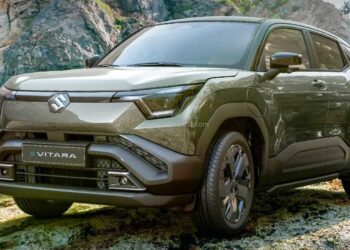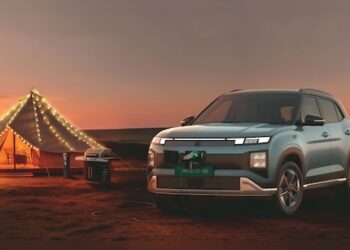The electric vehicle (EV) landscape is undergoing a transformative shift, with Chinese automaker XPeng introducing the P7+, a model that challenges established players like Tesla. Launched in late 2024, the XPeng P7+ combines advanced autonomous driving capabilities, impressive range, and competitive pricing, positioning itself as a formidable contender in the global EV market.
A. Design and Dimensions
1. Exterior Aesthetics
The XPeng P7+ boasts a sleek liftback design, merging the elegance of a coupe with the practicality of a hatchback. Measuring 5,056 mm in length, 1,937 mm in width, and 1,512 mm in height, it offers a spacious interior while maintaining aerodynamic efficiency. The vehicle’s drag coefficient stands at an impressive 0.206, aided by active grille shutters.
2. Interior Comfort
Inside, the P7+ emphasizes luxury and functionality. The cabin features a minimalist dashboard dominated by a 15.6-inch central touchscreen and a 10.25-inch digital instrument panel. Passengers benefit from heated, ventilated, and massaging seats, with rear passengers enjoying additional amenities like a dedicated touchscreen for climate and media controls. The panoramic sunroof enhances the sense of space, while the 20-speaker Dynaudio sound system ensures an immersive audio experience.
B. Performance and Powertrain
1. Battery and Range
The P7+ offers two battery configurations:
-
A. Long Range Max: Equipped with a 60.7 kWh battery, delivering a range suitable for daily commutes.
-
B. Ultra Long Range Max: Features a 76.3 kWh battery, providing an impressive range of up to 450 miles under the CLTC cycle.
Both versions utilize lithium iron phosphate batteries, known for their longevity and safety.
2. Charging Capabilities
Built on the SEPA 2.0 platform with 800V architecture, the P7+ supports ultra-fast charging. The 2025 Ultra Long Range Flagship trim introduces 5C charging speeds, allowing the battery to charge from 10% to 80% in just 12 minutes.
C. Autonomous Driving Technology
1. Vision-Based System
Departing from traditional LiDAR systems, the P7+ employs a vision-based autonomous driving approach. The AI Hawk system integrates:
-
A. Cameras: Eleven cameras, including single-pixel LOFIC sensors for enhanced low-light performance.
-
B. Radars: Three millimeter-wave radars.
-
C. Ultrasonic Sensors: Twelve sensors to detect nearby objects.
This setup is powered by dual NVIDIA Orin X chips, delivering 508 TOPS of computing power.
2. ADAS Features
The Advanced Driver Assistance System (ADAS) includes:
-
A. Lane Keeping Assist: Maintains the vehicle’s position within the lane.
-
B. Adaptive Cruise Control: Adjusts speed based on traffic conditions.
-
C. Automatic Emergency Braking: Detects potential collisions and applies brakes if necessary.
These features are available without additional subscription fees, contrasting with some competitors.

D. Market Positioning and Pricing
1. Competitive Pricing
XPeng has strategically priced the P7+ to undercut rivals:
-
A. Base Model: Starting at 186,800 yuan (approximately $26,100).
-
B. Mid-Tier Model: Priced at 198,800 yuan.
-
C. Top-Tier Model: Available at 218,800 yuan.
These prices position the P7+ as a cost-effective alternative to models like the Tesla Model 3.
2. Sales Performance
Since its launch, the P7+ has seen robust sales, with over 40,000 units delivered within four months. This success underscores XPeng’s growing influence in the EV sector.
E. Technological Innovations
1. AI-Defined Vehicle
XPeng markets the P7+ as the “world’s first AI-defined vehicle,” emphasizing its integration of artificial intelligence in driving dynamics, user interface, and system updates. The vehicle’s software receives regular over-the-air updates, ensuring continuous improvement and adaptation to user needs.
2. Manufacturing Advancements
The P7+ features an aluminum front and rear integrated die-casting body structure, crafted using the world’s largest 16,000-ton die-casting machine. This technique enhances structural integrity while reducing weight, contributing to better performance and efficiency.
F. Global Expansion and Challenges
1. European Market Entry
XPeng plans to expand the P7+ into European markets, leveraging partnerships with manufacturers like Magna for localized production. However, the company must navigate regulatory hurdles and adapt to regional consumer preferences.
2. Competition with Tesla
The P7+ directly challenges Tesla’s offerings, particularly in autonomous driving technology. While Tesla’s Full Self-Driving (FSD) system relies on a vision-based approach, XPeng’s AI Hawk system aims to deliver comparable performance without additional costs. This competition has intensified the race for innovation in the EV sector.
The XPeng P7+ represents a significant advancement in electric vehicle technology, combining cutting-edge autonomous driving features, impressive range, and competitive pricing. As XPeng continues to innovate and expand globally, the P7+ stands as a testament to the company’s commitment to redefining the EV landscape and challenging established industry leaders.

















